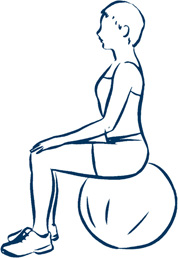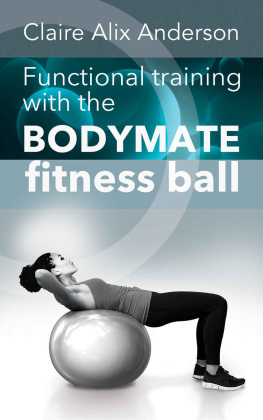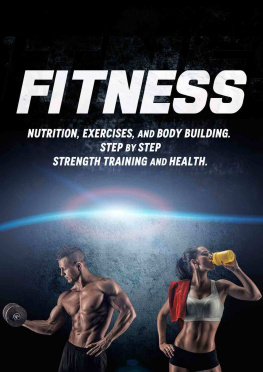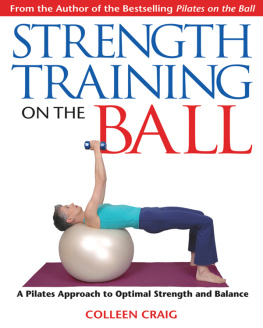FITNESS BALL
50 Exercises for Toning, Balance, and Building Core StrengthBy Olivia H. Miller with Norman Pugga Routhier A fitness ball is a terrific workout tool, but it can be hard to remember the exercises youve learned or to come up with new ones, since following correct form is important. Many fitness ball fans end up repeating the same exercises or resting their feet on the ball while watching TV or kicking it out of the way when cleaning. But to reap its benefits, the ball mustlike every piece of equipment or part of an exercise regimebe used regularly and correctly. Thats where
Fitness Ball comes in. This handy reference will help you ensure that your ball is used as a fitness tool, not a footrest.
Its the perfect way to remember exercises, learn new ones, and add variety to your workout.
What Are Fitness Balls?
Fitness ballsalso called fitballs, exercise balls, stability balls, physio balls, resistance balls, Swissballs, and posture ballsdebuted as toys in Italy during the 1960s. They were first used therapeutically in Switzerland to help patients with orthopedic and neurological problems. In the 1980s, physical therapists in the United States used them with clients who had hip, back, and knee injuries. The balls have now rolled into the mainstream as an effective tool for strength, toning, stability, and overall conditioning, and they continue to be excellent rehabilitation aids for injuries and chronic conditions. Consult with a physician or physical therapist about specific rehabilitating uses.
Countless exercises may be incorporated into a fitness ball routine, done from seated, standing, leaning, side, prone (on the stomach), and supine (on the back) positions. Many of the exercises here are adapted from traditional gym workout excercises, such as abdominal crunches, push-ups, squats, and tricep curls. The difference, and the challenge, is that the platform is unstable: Its a ball, and balls want to roll. To keep the ball under youand you on the ballyou must engage your abdominal, pelvic, and back muscles (often referred to as deep core stabilizers or just core stabilizers). Secondary stabilizer muscles in the upper thighs and buttocks are also engaged. Even the simple act of sitting on a fitness ball is a workout! With nothing to lean on, youre forced to sit up straight, and this engages your core stabilizer muscles.
Slight movements caused by breathing make you adjust constantly to maintain your balance. The benefits of simply sitting on the ball include improved posture and postural awareness, stronger muscles, and better balance.
How to Use Fitness Ball
Fitness Ball contains 5 warm-up and 45 exercise cards, plus an anatomy card for reference. The exercises are designed to work the major muscle groups: lower body, upper back, shoulders, chest, arms, and lower back and abdominals. The front of each card features an illustration of the warm-up or exercise; on the reverse are simple, bulleted instructions for doing the exercise safely and correctly, as well as a list of physical benefits.
Caution:Fitness Ball is not intended as a substitute for a certified instructor, trainer, physical therapist, or exercise class.
Caution:Fitness Ball is not intended as a substitute for a certified instructor, trainer, physical therapist, or exercise class.
If you havent exercised before, are pregnant or elderly, have a chronic condition, or have back or neck problems, please consult a medical practitioner before you begin. Dont do any exercise that causes undue pain, shortness of breath, or dizziness. Not all exercises are suitable for everyone. Your physical condition and health are important factors in determining which exercises and advice may be appropriate for you. This or any other exercise program may result in injury. The authors, consultant, illustra-tor, and publisher of this deck disclaim any liability from any injury that may result from the use, proper or improper, of any exercise or advice contained within.
Please consult your professional healthcare provider for information and advice on the suitability of your exercise program. You can develop your own routine by performing several exercises from each section, by focusing on a specific area of the body, or you can follow one of the .
Using the Ball
A good-quality, burst-proof ball costs around $30. When inflating the ball, follow the manufacturers instructions exactly. The size of ball you need depends on your height:

To enhance stability, use the ball on a covered surface (with a mat, rug, or carpet) and make sure there are no sharp objects or pieces of furniture nearby. The ball should be firm, but if you have trouble with balance or are fearful of falling off (a natural response at first), deflate the ball slightly or place it against a wall (resisting the temptation to lean your body against the wall).
Maintaining a neutral position is critical when using a fitness ball. During every exercise, engage your abdominal muscles by visualizing pulling your navel in and up toward the spine. This helps you keep your balance and is important for correct form and an effective workout. For added stability, try moving your feet wider apart when seated on the ball. Beginners should start with 1 set of 812 repetitions; gradually increase to 2 to 3 sets. Rest for approximately 1 minute between sets to allow the muscles to recover.
The use of external resistance (e.g., hand weights, ankle weights) increases instability and thus difficulty; dont incorporate them into your routine until you feel completely comfortable on the ball. When choosing resistance levels, start with weights you can handle while still maintaining proper form; gradually increase the weight by small increments. More advanced athletes can challenge themselves by adding more weight resistance where applicable and/or doing the more advanced version of the exercise (see Want more? at the bottom of each card). Using Fitness Ball regularly will increase your strength and stamina, improve your balance and stability, and enhance your muscle tone and overall conditioning. Its a great way to exercise, and we hope thatokay, well say ityoull have a ball! RECOMMENDED SEQUENCESBetter PostureBetter BalanceCore StrengthBack StrengthOverall Strength & Conditioning
Warm-up
01 PELVIC TILTS
Seated positionPrimary muscles: abdominals, low back extensorsSit on the ball with a straight, tall spine. (For increased stability, move feet slightly wider apart.) Hands rest on knees. (For increased stability, move feet slightly wider apart.) Hands rest on knees.
Engage your abdominal muscles by pulling your navel in and up toward the spine.
Gently tip your pelvis up, causing a slight rounding of your lower back. Hold for 10 seconds.Gently tip your pelvis down, causing a slight arching of your lower back. Hold for 10 seconds.benefits
Warms and loosens the lower back and pelvis Engages the core stabilizer muscles Assists with finding the neutral position important for proper form Increases postural awareness  fig. 01
fig. 01 






 To enhance stability, use the ball on a covered surface (with a mat, rug, or carpet) and make sure there are no sharp objects or pieces of furniture nearby. The ball should be firm, but if you have trouble with balance or are fearful of falling off (a natural response at first), deflate the ball slightly or place it against a wall (resisting the temptation to lean your body against the wall).
To enhance stability, use the ball on a covered surface (with a mat, rug, or carpet) and make sure there are no sharp objects or pieces of furniture nearby. The ball should be firm, but if you have trouble with balance or are fearful of falling off (a natural response at first), deflate the ball slightly or place it against a wall (resisting the temptation to lean your body against the wall).  fig. 01
fig. 01 